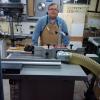Hi folks,
I'm working on building my first laminated workbench top after reading the Schwarz books and advice on this forum. I have already glued up four 7.5" wide subassemblies of my top. The individual boards in each subassembly are pretty well aligned since I used dominos to guide the glue-up. The edges are also still pretty square to the faces, and the faces are pretty clean of glue because I scrubbed pretty hard right after the glue up.
I'm wondering how best to prep the subassemblies before gluing them to each other. Schwarz recommends jointing and planing each subassembly before the final glue up. I can see how that would be smart, but I'm a little intimidated since each subassembly is already pretty heavy and I am not eager to lose too much more thickness (they are currently just over 3" thick each). Should I:
1. Go the whole way by face-jointing, edge jointing, and planing each piece, then squaring the other edge up by running through the TS? I have a solid 8" jointer but I'm not at all sure I can keep a 50# subassembly totally square to its fence or the TS fence. (I have a 12" dewalt planer) So I'm worried I'm going to lose a lot of thickness this way. (You can just tell me that losing 3/16 of thickness is no big deal in a 3" thick maple top) Plus, if I rip one edge in an effort to get it square it will end up less clean than the jointed edge I have now.
2. Trust that the edges are still pretty square, and just face-joint what will be the top face and glue?
3. Just glue it and go?





 Reply With Quote
Reply With Quote









